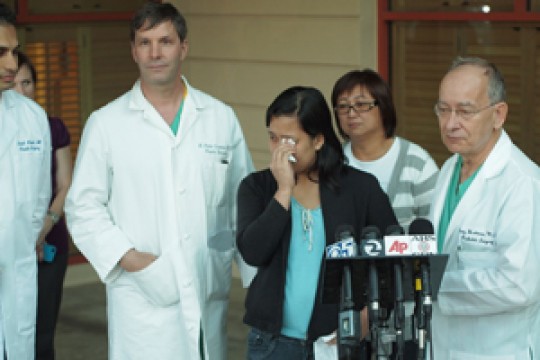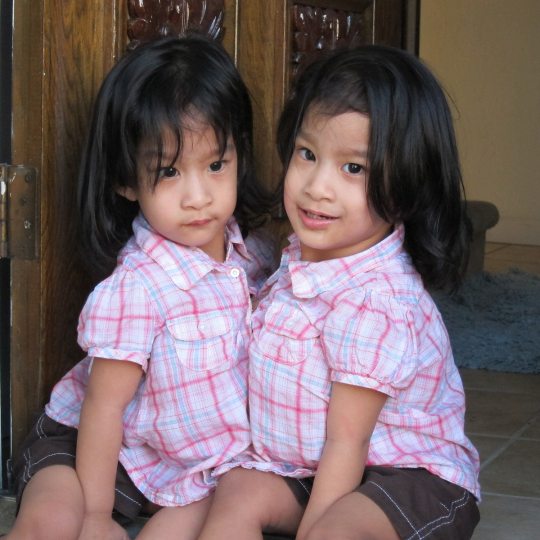Conjoined twin toddlers successfully separated at Packard Children’s
Conjoined twin toddlers successfully separated at Packard Children’s
…
Conjoined twins Angelina (left) and Angelica Sabuco at home in San Jose, Calif., shortly before their separation surgery
…
Angelica and Angelina Sabuco, twins who were born conjoined at the chest and abdomen, are now separate little girls.
The 2-year-olds were separated Nov. 1 in a 10-hour surgery at Lucile Packard Children’s Hospital. The operation was the culmination of several months of complex planning involving specialists from nearly every part of the hospital.
“This is a dream come true,” said the twins’ mother, Ginady Sabuco, speaking through tears at a news conference shortly after the completion of the surgery. “Words cannot express how the family feels for the successful separation of our twins, Angelica and Angelina.”
“We’re very pleased,” said lead surgeon Gary Hartman, MD. “Things basically could not have gone better.”
The riskiest portion of the procedure, dividing the girls’ fused livers, went slowly but smoothly, he said. Hemorrhage had been a concern because one quarter of the body’s blood supply passes through the liver each minute. But thanks to the state-of-the-art equipment the team used to divide the tissue and cauterize the girls’ blood vessels, virtually no blood loss occurred during that part of the procedure, said Hartman, clinical professor of pediatric surgery at the School of Medicine.
The surgery was the second separation of conjoined twins performed at Packard Children’s. The first pair was successfully separated in 2007 by a team that Hartman led. The Sabucos’ operation was less complex because they shared fewer organs.
In the summer of 2009, Ginady Sabuco was seven months pregnant when she learned her twins were conjoined. “I was asking God: why us, why me?” she said, recalling the day she got the news. It was especially difficult because her husband Fidel was living and working in San Jose, Calif., while Ginady and their son lived in the Philippines.
A year later, after the family was reunited in California, Angelica and Angelina were seen at Packard Children’s to evaluate their physiology and the risks of separation.
“I want them to live normally, like other children,” said Ginady, explaining the separation. In addition to the obvious psychosocial difficulties, remaining conjoined carried risks for the twins’ physical health, such as muscular and skeletal deformities that would have worsened with time.
“Already there are changes in their musculoskeletal systems,” Hartman said just after the surgery. The reconstructive surgery the twins received to their chests has already begun to alleviate abnormalities in the curvature of their chests and spines, he said.
To prepare for the surgery, the radiology team performed extensive imaging. “CT scans showed that the girls had separate hearts; their livers were tightly fused together; and their intestines touched, but their digestive systems functioned separately,” said Frandics Chan, MD, associate professor of radiology. “Their sternums were joined together; their ribs were separate.”
…

(Lucile Packard Children’s Hospital.) The twins’ mother, Ginady Sabuco, wipes away tears of gratitude as she speaks at a news conference Nov. 1 to announce the successful separation of the girls. Surgeons Rohit Khosla, MD, Peter Lorenz, MD, and Gary Hartman, MD, (L-R, in white coats) joined her.
…
The next step in the twins’ preparation, performed in July, was surgery to insert tissue expanders in four places under their skin. The expanders are small balloons, gradually inflated with liquid to prompt growth of extra skin that was used to repair their separation.
During the CT scan and the surgical procedures to implant and inflate the tissue expanders, the anesthesiologists kept a close eye on the twins’ responses to sedation and anesthesia. “We’ve anesthetized them five or six times now, and they’ve been very, very stable,” said Gail Boltz, MD, professor of anesthesia, before the surgery. The girls’ circulation was mostly unshared, which made anesthesia safer, she added.
Hartman, Chan, Boltz and Peter Lorenz, MD, professor of plastic and reconstructive surgery, devised a detailed plan for the surgery, which involved about 20 physicians and 15 to 20 operating room staff. They decided where each piece of equipment would stand and implemented a color-coded plan for keeping straight which personnel and tools were assigned to each twin.
The twins arrived in the operating room at 6:30 a.m. Hartman made the first incisions in the girls’ skin and muscle, and Lorenz cut through their rib bones. Hartman separated the girls’ diaphragms and livers, which were firmly adhered along their longest sides. Hartman then separated the girls’ bowels, and, shortly after noon on Nov. 1, cut the last bit of skin that joined the sisters. One sister was moved with her team to an adjacent operating room for reconstructive surgery — the first time in their lives that the two girls had been in different rooms.
Lorenz and Rohit Khosla, MD, assistant professor of plastic and reconstructive surgery, rebuilt the girls’ chest and abdominal walls. They implanted a thick, custom-made resorbable plate in each girl’s chest where the sternum should be, and grafted bone pieces removed during the separation onto the plates. The operation was complete at about 4:30 p.m.
“The plates will dissolve over about a year and a half,” Lorenz said. “That gives the grafted bone plenty of time to fuse, so eventually the girls will have normal bones and stable chests.”
After the surgery, the girls were moved to intensive care, where they are expected to recover for about a week before being moved to a regular room for another week or so. Then they’ll head home to San Jose to start their lives as two ordinary little girls. The twins may temporarily lose a few developmental milestones in the recovery period. For instance, they learned to walk together but may not immediately know how to walk alone. However, it is expected that they’ll quickly re-learn any lost skills.
And Ginady anticipates that many things will be easier — she’ll finally be able to give the twins breaks from each other when they argue — but that her daughters will still be basically themselves.
“Angelica is more talkative and Angelina’s a silent type,” Ginady said. The girls love to play “mommy and baby” with each other and listen to stories and music, she added. They know their colors and can count to 10. When Angelica coughs, Angelina gently pats her back.
Now, Ginady and Fidel are preparing the girls for the same ordinary challenges any parent anticipates. “I hope that when they grow up, they go to school, graduate and get stable jobs,” Ginady said. “I want them to have a good future.”
It’s a future that’s starting to look very bright. “They’re very resilient,” Hartman said. “The long-term prognosis is that we would expect a happy, healthy set of girls. We don’t see any barriers to a complete recovery.”
>>> Previous publications: Conjoined twin press conference, Packard Children’s Hospital <<<
>> Previous publications: Two separate girls! Packard Children’s surgeons separate conjoined twins <<<
>> Previous publications: Conjoined twins’ separation – a complex feat <<<
Please visit http://conjoinedtwins.lpch.org for additional information, artwork, photos and video of Angelica and Angelina.
###
* Stanford University Medical Center integrates research, medical education and patient care at its three institutions – Stanford University School of Medicine, Stanford Hospital & Clinics and Lucile Packard Children’s Hospital.
** The above story is adapted from materials provided by Stanford University School of Medicine
________________________________________________________________





















